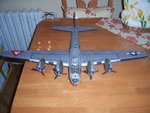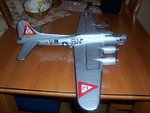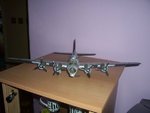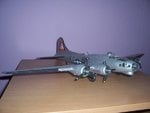seesul
Senior Master Sergeant
Alois Vasatko was born on the 25th August 1908 in Celakovice. When he finished his studies at the teachers institute he became a teacher in Litomerice but not for long. In October of the next year he started military service which he finished in spring 1929 when he moved to a school for Officers reserve Artillery. From here he moved again to the Army Academy in Hranice na Morave. After qualifying as a Lieutenant of Artillery he was posted to the 54th Artillery Regiment in Bratislava. In October 1935 he was promoted to the rank of 1st Lieutenant and he qualified on the course for Air Observers. Since November 1935 he served at the 2nd Air Regiment where he became commander of the 14th flight on the 31st December 1936. During the years 1937-38 he attended pilot training in Olomouc and on the 1st March 1939 he became an active pilot. After a short time the Germans occupied the country and Vasatko with a group of friends crossed the Polish border on the 13th July 1939. He had got to the camp in Male Bronowice via Tesin and Krakow. From there he sailed to France on the "Chrobry". The war had begun and "Amos" (nickname of Vasatko) was on the 11th September 1939 posted to fighter school at Chartres. He had finished his retraining on Curtiss Hawk 75 aircraft and on the 11th May 1940 he came to Suippes to the famous Grouppe de Chasse I/5. On the 17th May he had his first successful air battle. He shared the shooting down of one Bf 109 at Roucourt and he took part in the shooting down of a Henschel He126 at Stonre. Then he was appointed to the function of a flight commander. He was flying in combat regularly with his victories growing. On the 12th June 1940 he took part in the destroying of twelve enemy planes and he shot down three alone. During a dogfight at Vouziers where he shot down a Heinkel He111 he was lightly wounded. And on the 9th and the 15th June he made two crash landings with a damaged aircraft. He became the most successful Czechoslovak fighter pilot in the battle of France. At the end of June he flew together with his unit to North Africa and on the 5th August 1940 he arrived to port Cardiff on board the ship "David Livingstone". He then moved to the Czech camp at Cholmodeley Park and after a short time he was transferred to the Czech depot at Cosford. He joined the RAFVR with the rank of Pilot Officer and on the 5th September he came to the newly created No 312 (Czech) Fighter Squadron in the first group of pilots. On the 12th December 1940 he was appointed to the function of flight commander of "B" Flight and on the 5th June 1941 he became commander of the whole squadron. Under his lead No 312 (Czech) Squadron (at the time part of Kenley Wing) took part in first offensive flights over occupied France. Vasatko was involved with all these operations and on the 9th July he probably shot down a Bf 109 and damaged another one during In spring 1942 he helped with the organisation of the Czechoslovak Fighter Wing which consisted of No's 310, 312 and 313 (Czech) Squadron's and started its activities in June 1942. The first commander of this unit on 30th May was just Alois Vasatko. During an escort of Boston's over Cherbourg on the 3rd June he probably shot down one Fw190. Then came the fatal day, the 23rd June 1942 when the Czechoslovak Wing made an escort of Boston's during their air raid against an airfield in Morlaix. During their return near the coast of England No 312(Czech) Squadron attacked by a group of six Fw190 from above. Vasatko tried to manoeuvre to a better position for fight but his Spitfire "AV" had collided into one of attacking aircraft. Both planes then crashed into sea. The man whose name will be ever connected with the fight of Czechoslovak airmen on the Western Front has found his grave in the sea near the British coast. Alois Vasatko had been awarded many Czechoslovak and Allied orders and medals, Czechoslovak Order of the White Lion (in memoriam), Czechoslovak War Cross 1939 (three times), French Legion d'honneur – Chevalier, French War Cross (Croix de Guerre with seven palms, two golden stars and one silver star) and the British Distinguished Flying Cross (D.F.C.) which he obtained on the day of his death. By the order of the President of Czechoslovak republic of the 7th March 1992 was Alois Vasatko promoted to the rank of Major General in memoriam.
Josef Stehlik was born in Pikarec at Nove Mesto na Morave on the 23rd March 1915. He started pilot training at the Elementary Pilot School in Prague in 1936. The next year he studied at non-officer school and later at the fighter school in Hradec Kralove. Until the German occupation he served as pilot and instructor at No. 3 Air Regiment at Spisska Nova Ves. On the 5th June 1939 he crossed the border with Poland with the rank of Sergeant. After arriving in France at the end of August he joined the Foreign Legion. When the war began he was transferred to Chartres for retraining. On the 1st December 1939 he was posted to Groupe de Chasse III/3 which was equipped with Morane 406 aircraft but after short time was re-equipped by Dewoitine D-520 aircraft. With these aircraft the unit took part in air battle over France. In this time Stehlik showed his good ability when he shot down four enemy planes alone and four more in co-operation. After retreating by plane to Africa he sailed from Casablanca to Great Britain. On the 5th September 1940 he came as a Sergeant to Duxford to the newly created No 312 (Czech) Fighter Squadron. He took part in the Battle of Britain with this unit. Further victory resulted on the 14th March 1941 when he shot down another Ju88 over the sea in co-operation. During offensive flights over France he added to his score one damaged Bf109 and on the 10th July 1941 he probably shot down another plane of the same type. He left operational duty in October and after course for instructors at Upavon he became an instructor. At first he trained pilots at Hullavington and since January 1942 till February 1943 he served at Elementary and Secondary Flying Training Schools in Canada. In April 1943 he returned to No 312 (Czech) Squadron where he made many flights over occupied Europe. In January 1944 he moved to Soviet Union together with a group of 20 Czechoslovak pilots. After retraining on Soviet fighter planes La-5 he was posted on the 17th September 1944 to Slovakia as commander of one squadron of 1st Czechoslovak Fighter Regiment, which had, took part in SNP (Slovakian National Uprising). Next day after arrive to Slovakia he made a raid on the airfield in Piestany, which he knew very well from his pre-war service. During operations in SNP he added to his score one Ju88 and one half of Ju87. He has destroyed two more planes on the ground, five trucks, one locomotive and three other vehicles. After returning to the Soviet Union he was at the forming of 1st Czechoslovak Air Division where he was promoted to the function of second in command of the 2nd Fighter Regiment. With this unit he came to Prague in May 1945. For his brave service he was awarded the Czechoslovak War Cross 1939 (five times), Czechoslovak Medal for Bravery (three times), French War Cross with eight palms and many other Czechoslovak and Allied orders and medals. In post-war life Captain Stehlik took part in the creating of the new Czechoslovak Air Force. At first he became the commander of the retraining course for SNB members on Messerschmitt Bf109G aircraft and since the end of 1945 he became the commander of the course in Ceske Budejovice where he lead practice training of instructors for the Army Air Academy. Then in 1948 when he was discharged from the army and arrested for one year. There was an absence of evidence so he was acquitted, although he was degraded and since 1950 he worked as workmen at Pozemni stavby in Brno. In 1963 he became a driver and porter of luggage of patients in Lipova Spa near Jeseniky. In 1964 he was rehabilitated and he got back his rank and he returned into the army. He retired as a Colonel of the Air Force, and died suddenly on the 30th May 1991 in Slavicin.
Josef Stehlik was born in Pikarec at Nove Mesto na Morave on the 23rd March 1915. He started pilot training at the Elementary Pilot School in Prague in 1936. The next year he studied at non-officer school and later at the fighter school in Hradec Kralove. Until the German occupation he served as pilot and instructor at No. 3 Air Regiment at Spisska Nova Ves. On the 5th June 1939 he crossed the border with Poland with the rank of Sergeant. After arriving in France at the end of August he joined the Foreign Legion. When the war began he was transferred to Chartres for retraining. On the 1st December 1939 he was posted to Groupe de Chasse III/3 which was equipped with Morane 406 aircraft but after short time was re-equipped by Dewoitine D-520 aircraft. With these aircraft the unit took part in air battle over France. In this time Stehlik showed his good ability when he shot down four enemy planes alone and four more in co-operation. After retreating by plane to Africa he sailed from Casablanca to Great Britain. On the 5th September 1940 he came as a Sergeant to Duxford to the newly created No 312 (Czech) Fighter Squadron. He took part in the Battle of Britain with this unit. Further victory resulted on the 14th March 1941 when he shot down another Ju88 over the sea in co-operation. During offensive flights over France he added to his score one damaged Bf109 and on the 10th July 1941 he probably shot down another plane of the same type. He left operational duty in October and after course for instructors at Upavon he became an instructor. At first he trained pilots at Hullavington and since January 1942 till February 1943 he served at Elementary and Secondary Flying Training Schools in Canada. In April 1943 he returned to No 312 (Czech) Squadron where he made many flights over occupied Europe. In January 1944 he moved to Soviet Union together with a group of 20 Czechoslovak pilots. After retraining on Soviet fighter planes La-5 he was posted on the 17th September 1944 to Slovakia as commander of one squadron of 1st Czechoslovak Fighter Regiment, which had, took part in SNP (Slovakian National Uprising). Next day after arrive to Slovakia he made a raid on the airfield in Piestany, which he knew very well from his pre-war service. During operations in SNP he added to his score one Ju88 and one half of Ju87. He has destroyed two more planes on the ground, five trucks, one locomotive and three other vehicles. After returning to the Soviet Union he was at the forming of 1st Czechoslovak Air Division where he was promoted to the function of second in command of the 2nd Fighter Regiment. With this unit he came to Prague in May 1945. For his brave service he was awarded the Czechoslovak War Cross 1939 (five times), Czechoslovak Medal for Bravery (three times), French War Cross with eight palms and many other Czechoslovak and Allied orders and medals. In post-war life Captain Stehlik took part in the creating of the new Czechoslovak Air Force. At first he became the commander of the retraining course for SNB members on Messerschmitt Bf109G aircraft and since the end of 1945 he became the commander of the course in Ceske Budejovice where he lead practice training of instructors for the Army Air Academy. Then in 1948 when he was discharged from the army and arrested for one year. There was an absence of evidence so he was acquitted, although he was degraded and since 1950 he worked as workmen at Pozemni stavby in Brno. In 1963 he became a driver and porter of luggage of patients in Lipova Spa near Jeseniky. In 1964 he was rehabilitated and he got back his rank and he returned into the army. He retired as a Colonel of the Air Force, and died suddenly on the 30th May 1991 in Slavicin.




